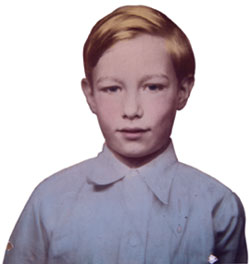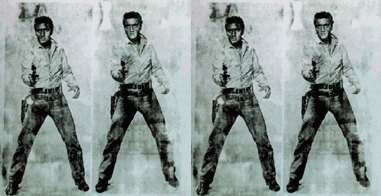New
Travel Package Features
Warhol’s Pittsburgh Tour
 Lynn Margolis Lynn Margolis
Tourists
from all over the world come to The Andy Warhol Museum
to
get a closer look
at the artist’s
groundbreaking creations. But for some, that’s
not enough: They want evidence of the humble life
that young Andrew Warhola led before his transformation
into Andy Warhol, pop-culture icon.
Until now, they were on their own—no
doubt tangling with confusing Pittsburgh maps as they
tried to figure out how to get to Bethel Park’s
St. John the Baptist Cemetery, where Warhol is buried,
or Oakland’s Schenley High School, where the
building blocks of his artistic career were stacked.
But
The Andy Warhol Museum and the Greater Pittsburgh
Convention and Visitors Bureau (GPCVB) have come to
the rescue. The bureau has put into action an idea
from Colleen Russell Criste, the Warhol’s assistant
director for External Affairs—a package titled
Andy Warhol’s Pittsburgh. It gives travelers
the opportunity to follow the path of Warhol’s
early life in an organized form —including
clear directions to each site.
Relatives visiting
for the holidays, curious couples
looking for something different to do, and pairs
of any sort—or multiples thereof—may
now purchase tickets that include admission to The
Warhol and Carnegie
Museum of Art, plus detailed information for self-guided
tours to the important landmarks of Warhol’s
first 21 years. It also includes passes for the UltraViolet
Loop, a Saturday-night bus service that ferries riders
to hip spots on the Pittsburgh social scene. Several
Pittsburgh hotels are offering special rates to package
buyers.
“In 2002, we presented this idea in a proposal to the
Cultural and Heritage Tourism department of the
GPCVB,” says
Criste. “The vision was that rather than
ask the GPCVB to support another short-term project
like
a special exhibition, we should establish a packaged
tour that could have a longer life span and support
not only The Warhol, but also the other amenities
around the city of Pittsburgh that relate to Warhol’s
life here.”
“This is like ‘All Things
Andy,’” says
Tinsy Lipchak, GPCVB’s executive director
of Cultural and Heritage Tourism.
According
to Criste, even casual Warhol fans want more
information about the environment
from which
a shy
boy emerged to become an enigmatic giant
of the art world. “Out-of-town visitors frequently
walk in our doors wondering why The Warhol is in Pittsburgh
rather than
New York City. Once they learn that Warhol was born and educated
here, they often indicate that they would like
to see places around Pittsburgh that highlight Warhol’s
formative years,” she says.
 Many of the
sites on the tour are in Oakland or nearby.
Besides the cemetery where Warhol
is buried,
the
only other semi-distant site is the Holy Ghost
Byzantine Catholic Church in McKees Rocks,
where Warhol’s
funeral service was held. If trekkers want
the real Warhol experience —and a serious
exercise challenge—they
can reach the other sites on foot, just like
Warhol did. They are: St. John Chrysostom Byzantine
Catholic
Church in Greenfield, where the Warhola family
worshiped; the family home at 3252 Dawson Street
in Oakland, where
he grew up; and Carnegie Mellon University
in Oakland. Many of the
sites on the tour are in Oakland or nearby.
Besides the cemetery where Warhol
is buried,
the
only other semi-distant site is the Holy Ghost
Byzantine Catholic Church in McKees Rocks,
where Warhol’s
funeral service was held. If trekkers want
the real Warhol experience —and a serious
exercise challenge—they
can reach the other sites on foot, just like
Warhol did. They are: St. John Chrysostom Byzantine
Catholic
Church in Greenfield, where the Warhola family
worshiped; the family home at 3252 Dawson Street
in Oakland, where
he grew up; and Carnegie Mellon University
in Oakland.
Warhol’s art training began
years earlier at Oakland’s Carnegie Museum
of Art, where he attended special Saturday
classes for outstanding art students.
Admission to the Museum of Art gives automatic
access to the adjoining Carnegie Museum of
Natural History,
where Warhol and his fellow students spent
time sketching the museum’s famed dinosaur
skeletons, and Carnegie Library, where he roamed
the stacks in search of information
for class assignments.
Besides some good photo ops, the tour will
give visitors something else: a more concise
picture
of the once
blue-collar city in which a boy raised during
the Depression found the drive and inspiration
to go
out and change
the world.
Packages are $30 per couple and may be purchased
online, along with separate hotel reservations,
through the
GPCVB at www.visitpittsburgh.com, or by calling
1.888.849.4753.
Featured Favorite
Elvis 11 Times

When Andy Warhol chose to re-create a
postcard publicity photo from the 1960 Elvis Presley
western, Flaming Star, he managed to instill in it
a duality that represents both the character and the
man: The macho cowboy commands, “Stay away!” while
the sexy heartthrob subliminally beckons, “Come
get me.”
That double message shoots from those
eyes, their straight-on stare so intense that they
appear to X-ray your very
soul. It jumps from the implied swagger of that I-dare-you-to-mess-with-me
stance, gun aimed and ready to fire, and the suggestiveness
of that partly unbuttoned shirt, strong jaw, and
plump bottom lip.
Then it multiplies until it becomes
Elvis Eleven Times, one of the most dramatic, imposing,
and popular
pieces
in The Andy Warhol Museum’s collection.
There’s a playful irony in Warhol’s decision
to turn a silver-screen image into a silver-screened,
larger-than-life portrait, but the bigger irony is
that he never planned for it to appear the way it
does at all. According to The Warhol Museum Director
Thomas Sokolowski,
the whole is the sum of several parts. Warhol made
his silk-screened images in assembly-line fashion,
Sokolowski explains. “He would paint multiple
images on fabric, then cut it into sections, like
buying fabric by the yard.”
When the works
were brought to the museum from the estate, Fred
Hughes, Warhol’s business manager
and executor of his estate, told the museum to
leave the canvas untouched.
“There’s really no evidence
that Warhol would have chosen to do it that way, but
it works,” Sokolowski
says, adding that Warhol just might have decided
he approved of Elvis Eleven Times, given his
propensity
to place replicated images together. After
all, he did once declare, “I like things to
be the same over and over again.” (He
prefaced that by saying, “I
like boring things,” but that hardly
applies in this case.)
Warhol produced many
Elvis canvases in color
and in silver, but there’s no evidence
that the real Elvis had any knowledge of them.
If he did, there’s
no record of his opinion, according to Sokolowski.
Back to Contents |